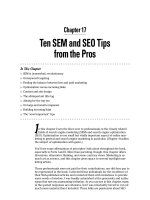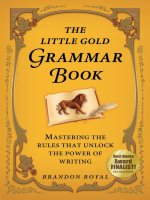Comma usage special excerpt from the little gold grammar book by brandon royal
Bạn đang xem bản rút gọn của tài liệu. Xem và tải ngay bản đầy đủ của tài liệu tại đây (552.65 KB, 25 trang )
THE
LITTLE GOLD
G
rammar
B
ook
MASTERING THE RULES
THAT UNLOCK THE POWER
OF WRITING
Brandon Royal
Published by Maven Publishing
© 2010 by Brandon Royal
All rights reserved. No part of this work may be reproduced or transmitted
in any form or by any means, electronic or mechanical — including
photocopying, recording, or any information storage and retrieval
system — without permission in writing from the author or publisher.
Reviewers, however, may quote brief passages in a review, and
individuals wanting to reference material from this book for academic
or non-commercial purposes may do so provided the book, with title
and author’s name, is cited as a source.
Published by:
Maven Publishing
4520 Manilla Road, Calgary, Alberta, Canada T2G 4B7
www.mavenpublishing.com
Library and Archives Canada Cataloguing in Publication:
Royal, Brandon
The little gold grammar book : mastering the rules that unlock the
power of writing / by Brandon Royal.
ISBN 978-1-897393-30-7
Library of Congress Control Number: 2009909354
In addition to the paperback edition, this book is available in the Adobe
PDF fi le format and through the Mobipocket digital platform, including
Amazon Kindle.
Technical Credits:
Cover Design: George Foster, Fairfi eld, Iowa, USA
Editing: Jonathan K. Cohen, Irvine, California, USA
This book’s cover text was set in Minion. The interior text was set in
Scala and Scala Sans.
Contents
Introduction 5
Chapter 1: The 100-Question Quiz 7
Subject-Verb Agreement 8
Pronoun Usage 12
Modifi cation 16
Parallelism 18
Comparisons 21
Verb Tenses 23
Diction Review 27
Idioms Review 29
Answers to The 100-Question Quiz 33
Chapter 2: Grammatical Munchkins 53
The Eight Parts of Speech 54
Parts of Speech vs. The Seven Characteristics 56
Other Grammatical Terms 58
Chapter 3: Word Gremlins 71
Diction Showdown 72
200 Common Grammatical Idioms 92
Chapter 4: Putting It All Together 99
30 All-Star Grammar Problems 100
Answers and Explanations 119
Editing I – Tune-up 147
Editing II – Punctuation Highlights 173
American English vs. British English 193
Traditional Writing vs. Digital Writing 201
Selected Bibliography 207
Index 209
About the Author
173
Editing II – Punctuation
Highlights
In spoken English, we can convey our meaning through voice
and body language: waving hands, rolling eyes, raising eyebrows,
stress, rhythm, intonations, pauses, and even repeated sentences.
In written language, we do not have such an arsenal of props; this
is the unenviable job of punctuation. Mastery of punctuation,
along with spelling, requires further review, and is not the focus
of this book. But two key areas — commas and semicolons — are
addressed because they represent areas where some of the most
common punctuation errors occur.
174
THE LITTLE GOLD GRAMMAR BOOK
Commas
It is said that ninety percent of writers can use the comma
correctly seventy-fi ve percent of the time, but only one percent
of writers can use the comma correctly ninety-nine percent of
the time. The comma is often used, but often used incorrectly.
The well-known advice that a comma be used whenever there is
a pause is terribly misleading. Arguably the best way to master
the comma is to think of every comma as fi tting into one of six
categories: listing comma, joining comma, bracketing comma,
contrasting comma, omission comma, or confusion comma.
Listing Comma
A listing comma separates items in a series. If more than
two items are listed in a series, they should be separated by
commas. The fi nal comma in the series, the one that precedes
the word and, is required (see Appendix II – American English vs.
British English for further discussion about the use of a comma
before a fi nal “and”).
Correct A tostada is usually topped with a variety of
ingredients, such as shredded meat or chicken,
refried beans, lettuce, tomatoes, and cheese.
Do not place commas before the fi rst element of a series or after
the last element.
Incorrect The classic investment portfolio consists, of
stocks, bonds, and short-term deposits.
Remove the comma placed after the word
“consists.”
Correct The classic investment portfolio consists of
stocks, bonds, and short-term deposits.
175
EDITING II – PUNCTUATION HIGHLIGHTS
Incorrect Conversation, champagne, and door prizes, were
the highlights of our offi ce party.
Remove the comma placed after the word
“prizes.”
Correct Conversation, champagne, and door prizes were
the highlights of our offi ce party.
Bracketing Comma
There are four main uses of the bracketing comma: (1) to set off
nonessential information in the middle of a sentence; (2) to set
off an opening phrase or clause; (3) to set off a closing phrase or
clause; and (4) to set off speech in direct dialogue.
First, bracketing commas set off nonessential (nonrestrictive)
information placed in the middle of a sentence. Such
information (in the form of phrases and clauses) is not essential
to the main idea of the sentence; in fact, we can test this. If after
omitting words the sentence still makes sense, we know these
words are nonessential and optional.
Correct The Tale of Genji, written in the eleventh century,
is considered by literary historians to be the
world’s fi rst novel.
The main idea is that The Tale of Genji is considered to be the
world’s fi rst novel. The intervening phrase, “written in the
eleventh century,” merely introduces additional but nonessential
information.
Correct The old brick house that is painted yellow is now
a historical landmark.
Correct The old brick house at O’Claire Point, which we
visited last year, is now a historical landmark.
176
THE LITTLE GOLD GRAMMAR BOOK
In the fi rst of the two examples above, “that is painted yellow”
defi nes which old brick house the author is discussing. In the
second example, the main point is that the old brick house at
O’Claire Point is now a historical landmark, and the intervening
clause “which we visited last year” merely adds additional but
nonessential information.
The second major use of the bracketing comma is to set
off opening phrases and clauses from the main sentence
(independent clause).
Correct Like those of Sir Isaac Newton, the scientifi c
contributions of Albert Einstein have proven
monumental.
A comma in the above sentence separates the
prepositional phrase “like those of Sir Issac
Newton” from the main sentence.
Correct Having collected rare coins for more than fi fteen
years, Bill was heartbroken when his collection
was stolen in a house burglary.
A comma separates the participial phrase
“having collected rare coins for more than
fi fteen years” from the main sentence. This
participle (or participial) phrase serves as an
adjective in describing Bill.
If the opening phrase is very short, the use of the comma is
considered optional. In the following example, the decision
whether to use a comma after “at present” rests with the writer.
Correct At present we are a crew of eight.
The third major use, though not as common as the fi rst two
uses, involves bracketing a nonessential closing phrase or clause
from the main sentence (independent clause).
177
EDITING II – PUNCTUATION HIGHLIGHTS
Correct I hope we can talk more about this idea during
the conference, if time permits.
A comma is used to set off the phrase “if time
permits” because this phrase functions as a
piece of nonessential information. If we deleted
these words, the sentence would still make
sense.
Correct They woke up at 6 a.m., when they heard the
rooster crowing.
Correct They woke up when they heard the rooster
crowing.
The fi rst of the above two sentences contains
a nonessential clause which is bracketed. The
fact that “they woke up at 6 a.m.” is the critical
information. The reason for their waking up is
auxiliary information. However, in the second
sentence, “when they heard the rooster crowing”
is critical information about why they woke up.
This restrictive information is not set off by
commas.
Note: A point of possible confusion occurs when a sentence
ends with a phrase or clause beginning with “which.” For
example, “I like that new brand of coffee, which is now on
sale.” It is common practice to place a comma before “which”
because it is assumed that such closing phrases or clauses are
parenthetical. That is, they do not contain defi ning or essential
information and should therefore be preceded by a comma. It
is also common practice not to place a comma before phrases
or clauses beginning with the word “that” because it is assumed
that such phrases or clauses do contain defi ning or essential
information. However, the question remains, Is a comma
really necessary, especially in this short sentence? One editing
trick is to substitute “that” for “which” in order to edit out the
178
THE LITTLE GOLD GRAMMAR BOOK
comma (along with the word “which”). Nonetheless, for those
who prefer to use “which” without the comma (at least in short
sentences as in the example above), one rationale for doing so is
the fact that these two words — “that” and “which” — are virtually
interchangeable in meaning.
The fourth major use of the bracketing comma is to set off
quoted speech from the speaker.
Correct The waitress said, “Welcome.”
“Thank you,” we replied.
The same treatment is afforded to unspoken dialogue or
“thought speech.” Most commonly it is enclosed within
quotation marks, but alternatively, it may be italicized to
contrast it with actual speech.
Correct “And what is the use of a book,” thought Alice,
“without pictures or conversation?”
Correct And what is the use of a book without pictures or
conversation?
Note that is not necessary to use both a speech tag (e.g.,
“thought Alice”) and italics, since use of both techniques is
redundant. Placing “thought speech” in quotation marks is
common practice in nonfi ction writing. Placing “thought
speech” in italics is common practice in fi ction writing.
Similar treatment is applied when setting off a quotation.
Correct Was it Robert Frost who wrote, “Good fences
make good neighbors”?
One important distinction arises between the direct quotations
and material that is merely surrounded by quotation marks. In
the latter situation, we punctuate, with reference to commas, in
exactly the same manner as we would “regular” sentences. This









